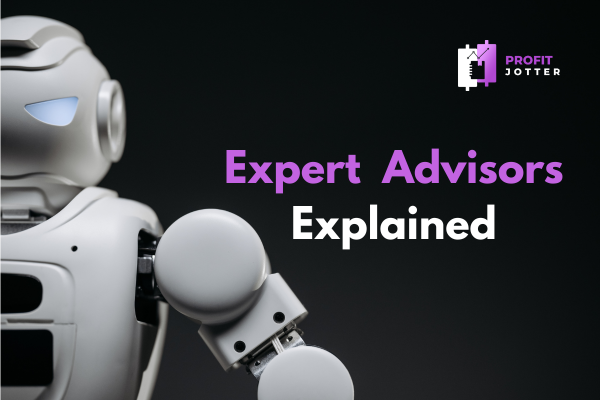Expert Advisors, or simply “EA” as often called, are software tools that automate trading processes in the Forex market.
These Expert Advisors are pre-coded programs used on trading platforms, like MetaTrader 4 (MT4) and MetaTrader 5 (MT5).
EAs are designed to help traders work seamlessly.
In this guide, I will give you insights on how EAs work, types of EAs, and more.
How Expert Advisors Work
EAs in Forex are coded in a programming language specific to trading platforms (MetaQuotes Language, MQL).
They analyze real-time data and historical price charts and perform complex calculations to identify profitable trade setups.
EAs are designed to assist traders by performing tasks that could be considered time-consuming or challenging, such as market analysis, identifying trade opportunities, executing trades, and even managing risk.
For example, if you want an EA to buy a currency pair when the price crosses above a moving average, you can set it up.
The EA will automatically execute the buy order for you when that condition is met.
Most EAs operate on simple rules, meaning they perform specific actions if particular market conditions are met.
This approach is known as Rule-based trading, which helps minimize emotional decision-making and stick to a structured trading plan.
Types of Expert Advisors
There are different types of EAs depending on what they are designed to do.
Here are a few common types.
→ Scalping EAs:
These aim to make small profits on many trades by capitalizing on minor price changes.
Scalping EAs usually open and close trades within seconds or minutes.
→ Trend-Following EAs:
These EAs are programmed to detect trends in the market.
They identify upward or downward trends and place trades in the trend’s direction, aiming to capture more significant price movements.
→ News-Based EAs:
These are designed to carry out trades based on economic news releases or major geopolitical events that cause market volatility.
News-based EAs can be highly profitable but are risky due to unpredictable market reactions.
→ Hedging EAs:
A hedging EA places trades in opposite directions on the same or correlated currency pairs to minimize potential losses.
→ Breakout EAs:
Breakout EAs monitor levels of support and resistance and place trades when prices break through these levels, hoping to profit from sudden price movements.
How to Set Up an Expert Advisor
Setting up an EA on MetaTrader is a straightforward process:
→ Step 1:
Download or purchase the EA.
You can find EAs in MetaTrader’s Marketplace or download them from trusted developers’ websites.
→ Step 2:
Install the EA on MetaTrader by copying it into the “Experts” folder in the MetaTrader directory.
→ Step 3:
Activate the EA by navigating to the “Navigator” section in MetaTrader, selecting “Expert Advisors,” and double-clicking on your EA.
Ensure the “Auto Trading” option is enabled for the EA to run.
→ Step 4:
Set parameters according to your preferences. Most EAs allow customization, such as adjusting trade size or setting stop-loss levels.
→ Step 5:
Monitor the EA’s performance, especially in the early stages.
Even though EAs are automated, it’s essential to check that they perform as expected and adjust settings if necessary.
Tips for Choosing an Expert Advisor
→ Research Thoroughly:
Look for EAs with a proven track record and positive user reviews.
Third-party platforms and forums can provide insight into other users’ experiences.
→ Start with a Demo Account:
Before using an EA with real money, test it on a demo account.
This allows you to see how it performs in real market conditions without financial risk.
→ Understand the Strategy:
Ensure you understand the trading strategy behind the EA.
This knowledge will help you determine if it aligns with your risk tolerance and trading goals.
→ Use Risk Management Tools:
Many EAs allow you to set risk management tools, such as stop-loss or take-profit levels.
These tools help protect your investment by minimizing potential losses.
Benefits of Using Expert Advisors
EAs bring many advantages to traders, especially for those new to Forex.
→ Automation:
With EAs, tasks that need to be repeated like monitoring currency prices, and ensuring the program places trades based on specific rules can be automated.
This saves time and reduces the stress of constantly checking the market.
→ Reduced Emotional Influence:
Since EAs are programmed to follow specific rules, they help eliminate emotional reactions to market fluctuations.
Beginners, in particular, often make emotional decisions, which can lead to significant losses.
→ Consistency:
EAs work around the clock, analyzing the market and placing trades according to their programming.
They help maintain consistency by following the trading strategy 24/7 without fatigue.
→ Backtesting:
EAs can work on historical data, helping traders refine their strategies before using them in real time.
This feature is crucial for assessing an EA’s effectiveness and understanding its potential risk-reward ratio.
Limitations and Risks of Expert Advisors
While EAs offer automation and ease, they come with limitations and risks:
→ Dependency on Market Conditions:
EAs perform well under specific market conditions but may fail during unexpected stability issues.
For example, a trend-following EA might not work well in a ranging market where there is no clear direction.
→ Overfitting:
EAs can sometimes be over-optimized for past data, meaning they work excellently in backtesting but may not perform well in live trading.
This is known as “curve-fitting,” where an EA is excessively customized to fit historical data.
→ Technical Issues:
Since EAs are software programs, they can encounter technical glitches.
Issues like internet interruptions or platform failures can affect trade execution, potentially leading to unexpected losses.
→ Lack of Flexibility:
EAs follow pre-set rules, which means they lack the flexibility to adapt to new, unforeseen market conditions.
→ Costs:
Some EAs are free, but others require payment or subscriptions.
High-quality EAs or custom-built EAs can be expensive, adding an extra cost to your trading.
Conclusion
Expert Advisors are powerful tools for automating Forex trading, providing convenience and removing some of the stress associated with active trading.
For beginners, EAs offer an introduction to trading strategies, allowing them to engage with the Forex market without being glued to their screens.
However, it’s essential to remember that no EA guarantees success; market conditions are unpredictable, and losses are possible.
Proper research, backtesting, and risk management are critical when using an EA.
By understanding the capabilities and limitations of Expert Advisors, traders can make informed decisions and potentially enhance their trading experience.



